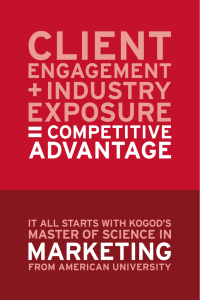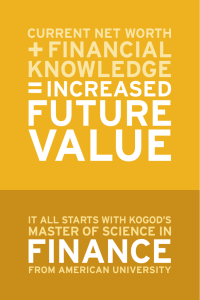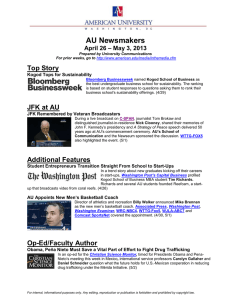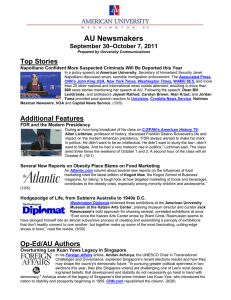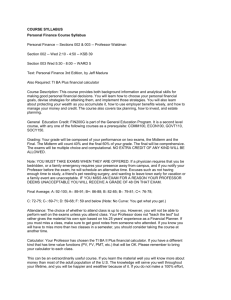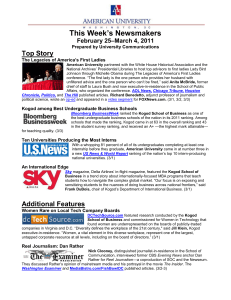Executive Briefing Series Leading Complex, Mission-Critical Projects
advertisement
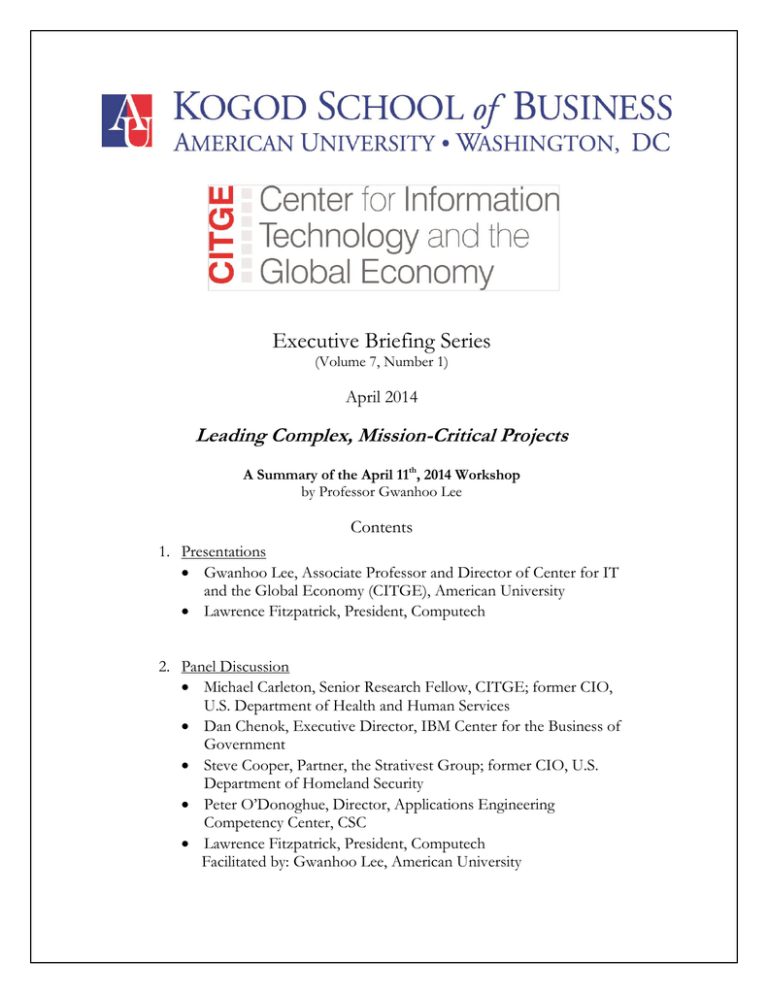
Executive Briefing Series (Volume 7, Number 1) April 2014 Leading Complex, Mission-Critical Projects A Summary of the April 11th, 2014 Workshop by Professor Gwanhoo Lee Contents 1. Presentations Gwanhoo Lee, Associate Professor and Director of Center for IT and the Global Economy (CITGE), American University Lawrence Fitzpatrick, President, Computech 2. Panel Discussion Michael Carleton, Senior Research Fellow, CITGE; former CIO, U.S. Department of Health and Human Services Dan Chenok, Executive Director, IBM Center for the Business of Government Steve Cooper, Partner, the Strativest Group; former CIO, U.S. Department of Homeland Security Peter O’Donoghue, Director, Applications Engineering Competency Center, CSC Lawrence Fitzpatrick, President, Computech Facilitated by: Gwanhoo Lee, American University Executive Briefing Volume 4 / Number 4 November 2011 Presentation 1: Managing Project Complexity By Gwanhoo Lee, American University Projects are increasing complex Examples include U.S. Navy ERP project (2,000+ persons), Healthcare.gov website project (55 contractors/subcontractors), Florida everglades project (duration: 30 years) The complexity of software has increased from tens of millions of lines of code to hundreds of millions of lines of code Complex projects fail too often Examples include healthcare.gov website, U.S. Air Force ERP project, U.S. Marine Corps ERP project Private sector is not an exception: JP MorganChase risk analysis tool project, Boeing Dreamliner project, Airbus A380 project Drivers for project complexity include: Large number of components in product, process, technology, and organization. Interdependencies among components Lack of clarity, ambiguity Technological novelty Conflicting goals of stakeholders Geographic dispersion Time zones Language/cultural barriers Diversity in team member background Multiple organizations are involved Impacts of complexity Increases in costs, duration, and defects Cost overruns: Suez Canal project (1,900%); Sydney Opera House (1,400%) Decreases in productivity and satisfaction Risk of integration failure Takes longer time to make changes High turnover of staff due to frustration, long work hours, and burnout Knowledge transfer problems during and after the project (tacit knowledge!) White space risks Even in software projects, organizational complexity has more profound impact on project performance than technological complexity does1 Why is it so difficult to manage complexity? 1 Source: W. Xia & G. Lee, “Grasping the Complexity of IS Development Projects,” Communications of the ACM, 2004 Executive Briefing Volume 7 / Number 1 April 2014 Limitation of human information processing capacity: Miller’s Magical Number Seven theory – No one knows everything about the complex project Nonlinearity between input and output: causality between them is not well understood Limitation of human social interaction capacity: Dunbar’s Rule of 150 (Human’s brain is designed to handle maximum 150 people in a social group) Should we blame lack of our PM knowledge and skills or lack of discipline in executing what we already know? Not all complexities are bad Designed (strategic, value-adding) complexity results from deliberate choices about where the business operates, what it sells, to whom, and how. (e.g., localization of services/products). Accidental (unnecessary, value-destroying) complexity arises from growing misalignment between the needs of the organization and the processes supporting it due to undisciplined actions (e.g., gloves in automobile factory)2 Different Types of Project Complexity Coping Strategies for Project Complexity The SUCCESS Principle o Simplify o Unpack the black box (visualization, transparency) o Consolidate o Chop (Divide)-Conquer-Integrate o Eliminate o Standardize o Self-organize/empower/decentralize People strategy o Raise awareness of the degree and impact of project complexity o Use common vocabularies/languages/metrics to communicate project complexity with stakeholders o Develop and sustain diversity in your team 2 Source: “Putting organizational complexity in its place, ”McKinsey Quarterly, May 2010 ©2014 Center for IT and the Global Economy, Kogod School of Business, American University P a g e |-2- Executive Briefing Volume 7 / Number 1 April 2014 o Get the right people onboard (ability to make sense of complex situations; ability to deal with high stress) o Shared knowledge between different units helps mitigate project complexity3 Product strategy o Eliminate features that are redundant or over-engineered (80/20 Rule) o Simplify requirements o Use tools to visualize project requirements o Increase modularity and loose coupling in product architecture Process strategy o Establish effective communication and coordination processes o Standardize core processes o Develop project dashboard – Peter Guber example The Diamond Approach4 Questions/Answers [Q] Where is Healthcare.gov in the Diamond? Based on the limited information available to us, we cannot know for sure where Healthcare.gov would be placed in the Diamond. However, to the best of our knowledge, it would be high on structural complexity, novelty and pace and medium (or even low) on technological uncertainty. Why did Healthcare.gov fail initially? -- Not everyone wanted the project to succeed since it was politically driven. To begin with, there was no model for the project. Requirements and business rules were discovered late in the cycle of creating the healthcare site. When October 1 came, there was no room for any requirement changes. 3 Source: J. Hahn & G. Lee, “Knowledge Overlap in Information Systems Development: An NK Fitness Landscapes Model,” Working Paper, 2011 4 Source: Shenhar & Dvir, “Reinventing Project Management,” HBS Press, 2007 ©2014 Center for IT and the Global Economy, Kogod School of Business, American University P a g e |-3- Executive Briefing Volume 7 / Number 1 April 2014 Presentation 2: What Every Cxo Should Know about Building and Operating Applications, but No One Bothered To Tell You By Lawrence Fitzpatrick, Computech Not only federal government but also private sector is really bad at managing complex IT projects “From 2003 to 2012, only 6% of federal IT projects with over $10 million of labor cost were successful. 42% were outright failures.”(Standish Report) Private sector is good at hiding this type of problems. That’s why we don’t hear as much about their failures Key Observations CxO have way more control than they think -- Hiring, funding and review Misinformation is pervasive, persistent, and pernicious Skills are not taught o Can’t learn at school – A craft with practice and with practitioners o Lessons are buried to protect the guilty o On-the-job training – past performance predicts future performance There is no “National Software Safety Board” Managing a complex project is just not that hard ...but it does require knowledge, experience, and discipline The Rules to Live By (… and frequently ignored) A business case ... Gut-check early Size matters … Big is bad o Arguably, the best run large-scale complex project is the space shuttle software program – 40 years spent $1 billion with very few defects or failures Product not project … Rome wasn’t built in a day Software management, not project management o Project management is a sub-discipline of Software management o Must understand architecture, staffing and hiring, and development practices, … The only metric … See actual working software Buy the environments ... Penny-wise and pound-foolish Software quality … If it hasn’t yet, it won’t (“Let’s hope …” does not work in PM) o Hope is a bad thing for software project o Look through lens of despair Skill matters … The 50X rule Commitment v. accountability … Plausible deniability triangle o Accountability and project management need to overlap (commitment) Salient transparency … Let math help X / Y ©2014 Center for IT and the Global Economy, Kogod School of Business, American University P a g e |-4- Executive Briefing Volume 7 / Number 1 April 2014 The Business Case – Gut-check Early Create a razor (a razor is a simple rule that helps you decide what’s “in” and what’s not.) What will the epitaph say? What if cost and time double, would it still have value? Be clear of what success looks like. It should have a clear and valuable outcome Cost: how much are you willing to pay? How much is it worth? For 20% of the money, 80% of capability – what is it worth to my organization? The Only Metric -- See Actual Working Software Regularly deliver high quality, working software to stakeholders o Regularly → at least every two months o Deliver → deployed to production-like environment o High quality → measurably, thoroughly tested o Working software → hands-on, end-to-end use o Stakeholders → customers, execs, users, governance, ops Agile as an emergent property -- To do the above, teams have no choice but to adopt practices that people call agile. One day, you wake up and realize “Hey, we’re agile!” Don’t be afraid to reboot -- If your team can’t demonstrate the above by six months into major project, you have the wrong team Skill matters … The 50X rule “...that "There are order-of-magnitude differences among programmers" has been confirmed by many... ~ Steve McConnell, Construx “Most things in life, the dynamic range is at most 2:1… In software..., the difference between average and best is 50:1, maybe 100:1… I’ve built a lot of my success by finding…” ~ Steve Jobs: Lost Interview, 39:15 Expect to See positive slope for team performance, pay for skill Moderate turnover is good since the team actively cultivates productivity Negativity productivity product: the bottom 10% will take the group backwards Questions/Answers Business Case: look at reverse of things and that everything is out and justify why it’s in – becomes forceful Easier to use what’s already made; deciding what should be in the “Boat” What do you do when you inherit the talent and mix of 10% sinking, 10% carrying the place, 80% to move them up or down, letting people go where it is not possible (unions)? o Transform existing orgs will take 3-5 years o Find those top performers, identify gaps, fill them (drivers of success) Discipline is short in supply – questioning other things ©2014 Center for IT and the Global Economy, Kogod School of Business, American University P a g e |-5- Executive Briefing Volume 7 / Number 1 April 2014 Panel Discussion: Leading Complex, Mission-Critical Projects: Best Practices and Lessons Learned Michael Carleton, Senior Research Fellow, CITGE; former CIO, U.S. Department of Health and Human Services Dan Chenok, Executive Director, IBM Center for the Business of Government Steve Cooper, Partner, the Strativest Group; former CIO, U.S. Department of Homeland Security Peter O’Donoghue, Director, Applications Engineering Competency Center, CSC Lawrence Fitzpatrick, President, Computech Facilitated by: Gwanhoo Lee, American University Michael Carleton No one else seems to refrain from speculation about healthcare.gov. Some problems are more from human psychology and behavior economics than strictly software development but they are related. Solutions: If we have a health exchange do over, what might be done differently? o There will be health insurance exchange in the US, many of them. Who has run a home modeling project? How does it go in terms of the original project schedule? With training and discipline. Most people, do it with accountability and the necessary incentives for financial and all the benefits in the long run. They don’t actually manage the project well. I think in 2012, according to studies, home owner modeling with a budget of $18,000 comes out with $38,000 later, with something that they are moderately satisfied with. That seems to be the norm in the industry. I do not mean that we do the complex things a lot worse than we do simple things but I think a lot of them gets down to human psychology and discipline. One of the most successful projects is in infrastructure area, from telecommunication to government contract work. o It’s hard, takes organization and discipline, but saves money. Many are critical, but at the end of the day I would say it’s a pretty specular success. I respect the healthcare staff for their full body of work during their 10 years work. Henry Charles, who made the prescription drug, Todd Park who made the data accessible. It’s pretty tough in the environment those projects took place. Psychological: If we favor something, we are driven to the best case scenario. People have succeeded and are more likely to assume to think they are good at other things. It is human nature, but some of the jobs are so costly that you have to think whether you are capable Behavior Economics: There is ample evidence when someone shows us a project, has a short outcome, compared to a probabilistic outcome, we will choose a short one even though the probability one in statistics might serve us better People have a fairly high tolerance of discipline in IT area than the general public. When a law passes, it describes the IT area ambiguity. Law, rule, solution and could include regulation and policies Most regulation for some areas is not taking effect. But some cases can’t be judged through the regular process ©2014 Center for IT and the Global Economy, Kogod School of Business, American University P a g e |-6- Executive Briefing Volume 7 / Number 1 April 2014 Federal Acquisition: should deal with the gap between expertise in capturing Federal contract and unrelated capacities in delivering the code Dan Chenok There are hundreds of federal government technology projects, for the most part, they generally work reasonably well. However, there are failures -- and from a portfolio view of complex, large projects, even as many elements proceed smoothly, there will be some problems to deal with. Definitions of failure can range, including both more systemic problems as well as components within a complex program that has many pieces Three things to highlight: o Aligning around clear goal and vision by the key stakeholders of making decisions in the process is critical. There are number of the projects in my experience that work really well with stakeholders knowing the mission of the project, and what their roles and relationships are in the delivery process of the project. If they don’t do this alignment, the frame can fall apart. o Different people often working for these projects, including government, agency leaders, and company executives. But there should be consistent incentives for them. For example, for industry partners who have financial incentives, if performance goals are written into the contract, the work can be done really quickly and well to ensure a stronger business result. o For government, it’s really hard to rely on the current funding and budget process to react quickly as projects need change. Companies can often shift more quickly than government can -- the appropriation process is very long. Another key element is to ensure you have the ability to review things, along with funding, and be able to react to things quickly as a team Steve Cooper Most of the latter part of my career has been as a chief information officer in private sector, public sector and non-profit sector. In some large organizations, Department of Homeland Security, CIO of Red Cross. Most people are not aware that the American Red Cross is a $6 billion USD organization, with two major business lines internal-blood business 15% of the nation’s blood supply, $3 billion, regulated, manufacturing environment. Totally depends on generosity of people, that 3billion USD budget has to be raised every year, from large organizations. But very little amount of money is from Congress every year, about 30-35million USD, that’s it. And that’s to run part of the notification to military services members. And still, it’s the Red Cross’s responsibility. Corning: Invest in technology, product about 65% of the world’s optical fire. Also produce now 60-65% LCD glass that most of you are carrying depending on what mobile devices you have including smart phone, or iPhone, iPad All these three organizations have in common: doing very large mission type activities on a large scale o Example: large complex program that didn’t go necessary as well as expected. Hint: think of the talk today of the likelihood to success in very large complex IT project. ©2014 Center for IT and the Global Economy, Kogod School of Business, American University P a g e |-7- Executive Briefing Volume 7 / Number 1 April 2014 FAA: Think of mission delivery o Two missions of FAA: 1. Safe operation of aircraft (air traffic organization) 2. Regulatory and oversight social responsibilities of commercial airline industry in general aviation in USA The application of FAA is called Aircraft control system, it was called whole system. The more recent replacement of that legacy system was a very complicated undertaking called ERAM. It is just about complete and is about 10 years old now. Think of the complexity. In order to bring a new system online, it has to some point replace the old one. How to do this in real time, when you actually operating aircraft, and has people and aircraft flying around Major issues need to be solved right away. How do you test to ensure the system do exactly what you want it to do? Safety and security. It’s too expensive to replace. Actually, they test it in a 100% like environment every day to ensure there are no safety problems. The original cost was estimated to be 2.5 billion USD, but the project now is approaching 6 billion USD. Twice as much as expected. It will succeed, but the contributing factor, in this case, was not only technology complexity, but also organization complexity. Peter O’Donoghue Applications are increasingly complex. Gwanhoo referred to SOA as a modern development pattern with great promise to improve application flexibility. While SOA is an excellent way to deisgn applications, we’ve found many difficulties in enterprise programs with SOA because our ability to manage change for SOA components and as importantly our ability to understand downsream dependencies seriously lags our technological capabilities. Modern distributed applications have gotten increasingly complicated and will continue to get more complicated. I like to think about the nature of the problem of complexity here, I’m currently reading a book that references and interesting a mathematical thought experiment posed by a Danish mathematician called Per Bak about a sand pile. The challenge is to develop an equation that predicts when a pile of sand that is formed by incrementally adding one grain of sand on top of each other at a time will eventually tip over. Why is it important? It’s important because it lures into a way of thinking that has been with us since the days of Newton which is that we can define a mathematical model that for everything that can process input into outputs. The sand pile turns out to be an unsolvable problem and the reason is because the it is in the interrelationships of each grain of sand within the pile that uniquely defines when any given pile will collapse. I like to think of it as an interesting metaphor for how we ought to deal with modern large scale application programs in that one needs to be comfortable knowing that there is uncertainty. The best program teams know there is uncertainty and even plans for it. My first major observation goes back to Larry’s presentation from earlier. I believe that mega-programs are very risky primarily because there are so many technology, people and process things that all need to be managed simultaneously and the relationships between each of these gets staggeringly difficult to manage. Therefore, you need to have a right leadership in all sides. The best leaders have some degree of comfort in knowing that they do not have all the answers, but are experienced enough to be account for uncertainty. ©2014 Center for IT and the Global Economy, Kogod School of Business, American University P a g e |-8- Executive Briefing Volume 7 / Number 1 April 2014 Second major observation is that in Washington DC, it can be challenging to have business owners be comfortable that perfect is the enemy of the good. If one considers the fundamental shift that agile development is built on, that is scope is changed to fit into time and resource availability ‘boxes’ that also requires a change in thinking on the part of business customer. If there is a customer who is inflexible with scope, time and resource commitment that can be very difficult. I’ve had flexible customers, and some not so flexible customers. To me, business customers who embrace the flexibility necessitated to be successful at agile development stand the best chance of success The third point is the concept of people. It’s critical that the impacts of the implementation of a new system and a set of processes are publicly endorsed by executives. The right people need to be in the right roles and be accountable to each other so that we know what changes and can build software together in parallel. I’ve seen great programs start quickly and be productive when they include teams that have experience working together. Many large program face a lot of inertia when brand new teams are stood up and significant losses of productivity are due to the classic forming, storming and norming of program startup when people really need to get their heads around what their responsibilities are and learn what their roles are. o There are some great examples of successful IT programs in the government context. We just delivered a major health care exchange program in New York State. There were many challenges. One was that the contract was awarded late. We, along with others building out health benefit exchanges, faced requirement elaboration as we got deeper into the program as policies were clarified, as operational considerations were being worked out and as other technological components were being fielded (see my first observation above). Why were we successful? First, we had a great customer who were flexible and also paved the way for us prior to us getting there. Secondly, we know NY health extremely well having run their Medicaid systems for over 20 years. Third, we had some of our better managers there who deftly arranged the program approach to work on the scope we knew was solid, and we moved the ‘uncertain’ scope elements around as requirements were clarified. It wasn’t quite agile but it was certainly incremental and iterative. But as important as anything, we fielded a great team who had worked together many times before. Folks on this team tend to be attracted to our more challenging programs and the team included about 20-30 of our best people. They interpersonal relationship, predefined relationships and knowledge of who is going to what, exactly know what each role means, and the deep trust is there. We fielded a great team with a deep understanding of the nature of the program. Lawrence Fitzpatrick Challenge for a business student project: create a business case for a state healthcare exchange. Given that Feds are building one as default, the cost per customer acquisition looks way out of the norm for insurance industry, etc. ©2014 Center for IT and the Global Economy, Kogod School of Business, American University P a g e |-9- Executive Briefing Volume 7 / Number 1 April 2014 Questions/Answers [Q] Governments, non-profits, and private sectors can learn from one another, such as challenges in politics. Any response to the fact that the private sector actually mirrors the public sector? People react on their best interest, whatever you can get, from individual interest to a line of team interest, to a line of organizational interest, you are going to win, because fundamentally most of us want to do well, want to be in successful organization and undertaking initial enterprises. Things do get slightly out of the light. I talked about small p politics and capital P politics, small one is what we experience every day, and I think this is what you are asking. Capital P is where dysfunctional capital lies, but I don’t have a solution to that. Unfortunately, it does impact the federal government in large complex projects, but it’s much easier to get all those interest a line when the worst thing involved. By “decomplexifying,” it is easier for people. Small politics is easier to do. It’s easier for automatic decision to get to the board or the CEO. When you get there, you have a decision made and then you can go on. But it’s very different from the federal government. Sometimes you question “Is there an automatic decision maker?” (Steve Cooper) Interest group pressures are always present in the government space, and there is a lot politics involved. Interest groups impact law, policy and dollars. This can be a good thing in democracy; you have the interest group representing the legitimate interests of constituents. How this plays out in impacting management of complex IT programs is an issue that we should pay attention to. (Dan Chenock) Psychology for the day: I have to do consulting with some companies that are true value companies. They have some relationship with the federal supply, but some companies out there do not wish to be federalized. Not all groups are ready to accept that. If there are many people in an organization who want something down, it is not about the software, it is about the politics and interest groups. Mission changes according to the administration. The public sector spends a lot of time considering those they choose to not work with. In the private sector, I probably would not choose to deal with the people who are not going to work with me that way. In the public sector, when they conduct a project, they need to consider there is a process to make sure things are done fairly. (Michael Carleton) Failure in the private sector and public sector occur in massive projects (Lawrence Fitzpatrick) Work as a consultant in private industry and its notable that work in the private sector is motivated by profit. Everything was measured by this. If things made sense from a bottom line, we’d just get on with it and deliver. There are two concrete examples of how things are different working in government. One relates to the government shutdown. One of my former programs had to plan for a surge in workload coming through a system as it was brought back online after the shutdown ended which turned out to be more complex than one would imagine. The second example has to embed dates in your application for when laws would come into effect. We are able to use business rule solutions and parameter driven logic, but still it makes testing challenging and adds to complexity. ©2014 Center for IT and the Global Economy, Kogod School of Business, American University P a g e | - 10 - Executive Briefing Volume 7 / Number 1 April 2014 I find that the profit motive is simple; things are just based on this. (Peter O’Donoghue) [Q] Considering the successful federal projects, the best thing is landing on the moon. The mission is very clear, bring a mam on the moon and bring him back alive. If you know where you are going, the mission will take you there. How would you take confusing, moving big things? The best government customer is the one who has the clear mission. That group is very interesting; they behave like they have important problems. They felt like they are the entrepreneurial spirits. When the mission is fuzzy, and when you have a lot of people in the program, change organization commitment. IT people tend to look at the world very rationally, you cannot have alcohol at Sunday in Massachusetts, and it turns out this actually works perfectly, because people think they should not drink on Sundays. It makes political sense. Some missions are blurry just because no one thinks about it. [Q] Risk management. What is a risk? How do you evaluate it? How to tell your employee about the risk as a risk manager since they don’t have the same risk orientation as you do? Many agencies of Federal government do not evaluate risk well at all. Some do -- think about the students default under loans, we don’t stop the program because of the default. However, most of the Federal sector, especially in the IT industry, doesn’t have a good understanding about it, like how to quantify risk or how to accept risk. (Dan Chenock) An example for looking at thing and think positively. FAA, risk management unit, did talk to a lot of people and get information. The other thing we did after we establish that group. The FAA is extremely risk reverse: we have a big problem in changing the field of the HR database, because they think the change will crash small planes. It is a formal risk control activity, they did very well in the risk control. But in a giving time frame, start to push is when we look for risk elimination. A project, a skewed, hit this period time in this project, did work on small project, including backing up the power resource. (Steve Cooper) ©2014 Center for IT and the Global Economy, Kogod School of Business, American University P a g e | - 11 - Executive Briefing Volume 7 / Number 1 April 2014 Attendees (order by affiliation) First name Ajay Adhikari Organization American University Title Senior Associate Dean for Academic Affairs MBA student Undergrad student Term professor MBA student Senior Research Fellow Senior Research Fellow and Professor Emeritus MBA student Professor and Director, CITGE Naif Alawi Hamdi Alaud-din Frank Armour Jed Benjamin Byers Michael Carleton Mary J. Culnan Erin Davis William DeLone American University American University American University American University American University American University & Bentley University American University American University Mukund Dubey Ahmed El-Eraky J. Alberto Espinosa Michael Ginzberg Juan Hurtado Stephanie Janeiro Gwanhoo Lee American University American University American University American University American University American University American University Amanda Leese Laura McClintock Pankhuri Mishra Emma Nordbäck Ann Parambil American University American University American University Aalto University in Finland & American University American University Randy Saba American University Program Lead, Project Management Office Director of Student Information System Suresh Nallapati CareFirst BlueCross BlueShield Enterprise Architect Lawrence Fitzpatrick Computech President Rick Galasso CSC Project Manager Peter O’Donoghue CSC Young Hoon Kwak Mohamoud Jibrell George Washington University Howard Hughes Medical Institute Dan Cheno Trevor McClintoc IBM Center for the Business of Government Straidvalley Group Director, Applications Engineering Competency Center Associate Professor Vice President for Information Technology Executive Director Steve Cooper Young J. Kim Strativest Group Young Enterprise Systems MBA student MBA student Professor Dean, Kogod School of Business Undergrad student MBA student Associate Professor and Director of CITGE MBA student Visiting Scholar MBA student Visiting doctoral student CEO Partner President ©2014 Center for IT and the Global Economy, Kogod School of Business, American University P a g e | - 12 - Executive Briefing Volume 7 / Number 1 April 2014 Presenter/Panel Bios Michael Carleton Former CIO, U.S. Department of Health and Human Services Senior Research Fellow, Center for IT and the Global Economy, American University Michael W. Carleton served as Chief Information Officer (CIO) for the United States Department of Health and Human Services (HHS) and the General Services Administration (GSA). Mr. Carleton holds a Master of Science in Information Resources Management from Syracuse University and a Master of Public Administration from Northeastern University. He is also a distinguished alumnus of the National Defense University’s Information Resources Management College and the Society for Information Management International's Regional Leadership Forum. He is a past president of the Capital Area Chapter of the Society for Information Management. Dan Chenok Executive Director, IBM Center for the Business of Government Dan Chenok is Executive Director of the IBM Center for The Business of Government. He oversees all of the Center's activities in connecting research to practice to benefit government, and has a special focus on technology, regulation, budget, and acquisition issues. Mr. Chenok previously led consulting services for Public Sector Technology Strategy, working with IBM government, healthcare, and education clients. In addition, he is the Chair of the Cybersecurity Subcommittee of the DHS Data Privacy and Integrity Advisory Committee, Vice-Chair of the Industry Advisory Council Executive Committee, CIO SAGE with the Partnership for Public Service, Chair of the Policy Coordinating Committee for the National Strategy for Trusted Identities in Cyberspace Identity Ecosystem, Fellow of the National Academy of Public Administration, and generally advises public sector leaders on technology policy. Steve Cooper Partner, The Strativest Group Steve Cooper is a founding Partner of the Strativest Group, LLC, assisting clients with business and ‘goto-market’ strategies, and strategic investment decisions. He serves as a Board Member of several technology companies and as the Chair of the City of Alexandria, Virginia’s Information Technology Commission. He served as Chief Information Officer in the public, NGO, and private sectors, and as president and CEO of technology startups. ©2014 Center for IT and the Global Economy, Kogod School of Business, American University P a g e | - 13 - Executive Briefing Volume 7 / Number 1 April 2014 Lawrence Fitzpatrick President Computech Lawrence Fitzpatrick, President of Computech, a 30-year old IT application development firm, has particular expertise in online auctions, data driven dashboards and legacy system replacement. His record of successful software delivery and transformational software management has spanned academia and government, commercial software product development and corporate IT for over 25 years. Prior to joining Computech, Lawrence served as Senior Vice President of the Financial Industry Regulatory Authority (FINRA). During a time of substantial change in the financial sector, he created FINRA’s architecture group, built an application development team of over 500 individuals and led the delivery of numerous key systems. Previously, Lawrence led the delivery of commercial software products as Technology Vice President at Open Text Software (OTEX) and as Chief Technology Officer at Personal Library Software. He has specialized in text retrieval and analysis, high performance computing and database systems and delivered industry-leading commercial software that has been widely used. Lawrence is a frequent author to industry trade publications and sought after to speak on enterprise infrastructure, IT-driven transformation and innovation within the government sector. He has a Master’s in Biomedical Engineering (Informatics) from The University of Virginia and a Bachelor of Science in Biology with a minor in Computer Science from Georgetown University. Gwanhoo Lee Associate Professor of IT Director, Center for IT and the Global Economy Kogod School of Business, American University Professor Lee teaches project management, enterprise process and system, and corporate information strategy in the Kogod School of Business, American University, Washington, D.C. His primary research areas include project management, managing complex projects, agile software development, open collaboration and innovation, digital government, public value of IT, and CIO leadership. He has worked closely with IT executives from sizable U.S. and international organizations including 3M, American Red Cross, AMTRAK, Cargill, CSC, Deloitte, FAA, Freddie Mac, GAO, HHS, IBM, LG CNS, Marriott, Medtronic, Northwest Airlines, Samsung Electronics, Samsung SDS, Pfizer, and World Bank. His research has been published in MIS Quarterly, Journal of Management Information Systems, IEEE Transactions on Software Engineering, European Journal of Information Systems, Communications of the ACM, Information & Management, Journal of Information Technology, Information Technology and People, Journal of Information Technology Management, and IEEE Pervasive Computing. He was the runner-up for the best paper award for OCIS division in Academy of Management Meeting in 2007. He earned his B.S. and M.S. in Industrial Engineering from Seoul National University and his Ph.D. in Information Systems from the University of Minnesota, Minneapolis. He is an advisory fellow to Samsung Economic Research Institute (SERI). ©2014 Center for IT and the Global Economy, Kogod School of Business, American University P a g e | - 14 - Executive Briefing Volume 7 / Number 1 April 2014 Peter O’Donoghue Director, Applications Engineering Competency Center, CSC Peter provides strategic leadership to infuse innovation into CSC’s US governmental application delivery business. Peter has over 20 years providing engineering solutions to large complex problems internationally. Mr. O’Donoghue has been a pioneer in delivering applications modernization, SOA, MDM and cloud solutions to the US and Australian government in his time at CSC. Prior to CSC, he led major business and technology transformations for Global 100 organizations, including early Internet of Things implementations. ©2014 Center for IT and the Global Economy, Kogod School of Business, American University P a g e | - 15 - Executive Briefing Volume 7 / Number 1 April 2014 CITGE Executive Team Dr. William H. DeLone Executive Director, CITGE Professor, Kogod School of Business, American University Dr. Gwanhoo Lee Director, CITGE Associate Professor, Kogod School of Business, American University Dr. Richard J. Schroth Executive-in-Residence, Kogod School of Business, American University CEO, Executive Insights, Ltd. Dr. Frank Armour Research Fellow CITGE Advisory Council Steve Cooper CIO, Air Traffic Organization, Federal Aviation Administration Bill DeLeo Director of Release Engineering Architecture, SAS Mohamoud Jibrell CIO, Howard Hughes Medical Institute Associated Faculty and Research Fellows Dr. Erran Carmel Professor, Kogod School of Business, American University Joe Kraus CIO, U.S. Holocaust Memorial Museum Dr. J. Alberto Espinosa Associate Professor, Kogod School of Business, American University Ed Trainor former CIO, AMTRAK Dr. Mary Culnan Senior Research Fellow Slade Professor of Management and Information Technology, Bentley College Susan Zankman SVP of Information Resources Finance and Management Services, Marriott International Michael Carleton Senior Research Fellow Former CIO, U.S. Department of Health and Human Services ©2014 Center for IT and the Global Economy, Kogod School of Business, American University P a g e | - 16 -

